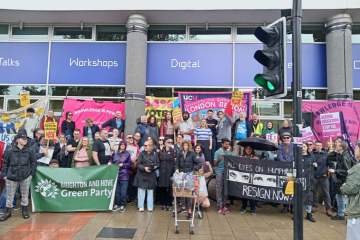The changes to junior doctors contracts is the result of the crisis of capitalism that came dramatically to the surface in 2008 and has not be resolved since.
The proposed changes to the contacts
Four years after the question of NHS reform was originally raised the idea of a ‘7-day NHS’ was finally put forward by the government as not all elective procedures were carried out over the weekend. In June 2012, 13 NHS trusts set up the ‘South West Pay, Terms and Conditions Consortium’ (SWPTCC) to operate locally and separate from the national NHS. And in June 2013, the British Medical Association (BMA) which represents doctors was asked to enter negotiations over junior doctors’ contracts.
The government’s proposed plan is as follows
- An extension of standard working time from 60 hours to 90 hours per week.
- The end of banding payments.
- The end of banding safeguards without an alternative to prevent unsafe hours to ensure you are paid when shifts overrun.
- Removal of the GP speciality training supplement.
- Replacing hours-based pay for non-resident on-call duty with a single ‘allowance’ to compensate you for being available.
- The end of automatic annual pay progression, with pay linked to stage of training instead.
- The use of ‘flexible’ pay premiums to partly make up for the loss of pay protection and automatic pay progression to some trainees.
- The use of flexible pay premiums to incentivise recruitment to shortage specialities.
- No increase in annual leave, and no firm action to stop fixed leave.
- Juniors earnings for doing private professional work would have to be handed over to their employer if the work was done during NHS time.
- Juniors must be reimbursed for their relocation expenses and employers can’t set arbitrary limits on this.
- A change to the total pay available for sharing among juniors.
In July 2014, the government involved an independent body called ‘Doctors and Dentists Review Body’ (DDRB) to evaluate the contract and report back, which happened in July 2015. The BMA then stated that the contract is unsafe and unfair and did not agree to re-enter negotiations, at which point the government said it would enforce the contract non doctors by August 2016.
Therefore, in September 2015, the BMA decided to ballot junior doctor members for industrial action. More than 37,000 junior doctors (76.2%) voted, and of them more than 99% voted for some form of industrial action, while 98% voted for full strike action.
Whether consciously or unconsciously junior doctors can see that capitalism has reached its limits and is putting them, along with the rest of the working class and the public sector, under further austerity and pressure. The result is that even doctors, who were previously considered to be ‘apolitical’, can be massively mobilised for strike action and to stand up to the ruling class and their Tory representatives.
A strike was set for December 2015, but it was called off as the government asked the BMA to come to the negotiating table one more time, thus talks between the government and the BMA were restarted in January 2015. Unsurprisingly the talks did not result in a solution. In a capitalist system nothing but the safeguarding the profits of 1% of the society matters, if the BMA stands in the way of this the Tories will refuse to compromise with them.
As a result, the BMA has carried out several rounds of strike action and has set three more 48 hour strike dates, the first of which began today (Wednesday 9 March).
Why are the contacts being imposed?
This situation is a result of austerity – fighting the imposition of these contracts is the same fight as the struggle against austerity more generally. So we must examine why austerity has been implemented. Since the collapse in 2008 the world economic market has been in crisis. This crisis is the longest ever seen – growth on a world scale is in the doldrums. This slowdown of the global market has forced the implementation of austerity. To reduce the spending of the government in times of crisis only the bare essentials required to maintain a society are maintained. These meagre resources are spread as thinly as humanly possible.
The office of national statistics has shown 631,000 job losses in the public sector since 2010. The cuts to welfare alone have amounted to over £51 billion since 2010. We have seen mass opposition to these cuts with demonstrations of 250,000 people. However these have not prevented the onslaught of austerity. Why? Because there has been no political expression of this anti-austerity movement until the recent election of Corbyn as Labour leader.
Promises about the NHS made by this government came from a time when they had hoped the global market would strengthen. Instead they have trimmed all the fat that the welfare system can manage but the economy is still struggling. Now they must find a way to somehow exploit the workforce further, or else sacrifice their own class’s wealth and fundamentally threaten the capitalist system it is based on. As a publically funded pillar of British society the NHS was inevitably a last resort.
Marx stated in the Communist Manifesto that “[Capitalism] has converted the physician… into its paid wage labourer”. Thus, as capitalism’s paid wage labourers junior doctors were inevitably going to get a knock on the door from austerity at some point as the crisis deepened. Not only is it the aim of austerity to reduce the public spending on junior doctors. It goes further: it aims to starve the NHS of funds and to break it down brick by brick until its failing allows full privatisation.
This privatisation of the NHS would allow the ‘burden’ of healthcare to be managed by insurance companies. True to the nature of capitalism this would open a new market and create new profits to be made. The largest source of personal debt in the USA, for example, is now medical debt. So instead of collectively supporting a healthcare system through taxation, the burden would fall on the individual. In effect then many may soon be too poor to be sick.
This austerity has created huge levels of unemployment and underemployment whilst at the same time the richest 1% have increased their wealth. The 2016 Oxfam Report of inequality shows that the wealth of the poorest 50% of the world’s population has decreased by £720 billion since 2010, even though this percentage of the population has increased by 400 million people. Meanwhile the richest 62 people’s wealth has increased by £1.3 trillion. This now means that 62 people now have the same wealth as 3.6 billion people.
Any socialist would tell you that the answer to this problem of austerity is fundamental, revolutionary change. But why? Why is a revolution needed now that we have Corbyn promoting an anti-austerity agenda within parliament? You only need look at Greece to answer this. In that country it didn’t matter that a democratically elected government attempted to undertake anti-austerity policy. They were denied that option by the Troika, (European Central Bank, International Monetary Fund and European Commission) with Germany pulling all the strings. This trampling of democracy is the reality of trying to change the system from within, at a time when the system can afford no concessions.
In reality the only way to ensure that all ordinary people reap the benefits of the products and services they create is through expropriation of the means of production by the working class. Don’t leave them in the hands of the 1% but give them to the people who work and use them. That way you could run society according to need, not profit. You could put an end to austerity and you could invest in the NHS instead of cutting it. Therefore a revolution involves bringing the economy into public ownership.
With the warning signs of another world slump in 2016 and no increase in global economic growth all that capitalism has to offer is austerity. The only way to truly combat the threat of austerity on the junior doctors, the NHS and more broadly is a socialist revolution.
Conclusion
The next step for us is to support any struggle against austerity, like the struggle of the junior doctors against the imposition of the contract on them by the government. We must join the picket lines, show our support for junior doctors, talk to them about the situation in which they find themselves, and draw the parallels with the situation in the rest of the NHS, the country and the world.
The ultimate goal is an NHS-wide strike, and then on to a general strike. We need the unity of all workers for a real movement to take control of the economy into the hands of the organised working class. The last general strike in the UK was in 1926, perhaps the junior doctors can pave the way for the next one eighty years later.
by Ana Alavi and Dan Hudson, UEA Socialists



